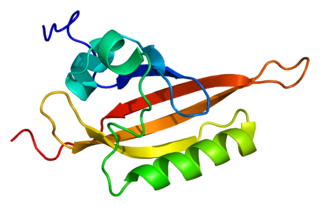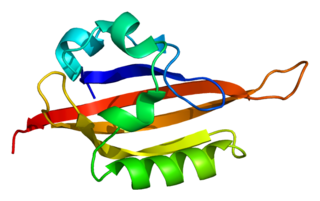Hypoxia-inducible factor 3 alpha is a protein that in humans is encoded by the HIF3A gene. [5] [6] [7]
Hypoxia-inducible factor 3 alpha is a protein that in humans is encoded by the HIF3A gene. [5] [6] [7]
The protein encoded by this gene is the alpha-3 subunit of one of several alpha/beta-subunit heterodimeric transcription factors that regulate many adaptive responses to low oxygen tension (hypoxia). The alpha-3 subunit lacks the transactivation domain found in factors containing either the alpha-1 or alpha-2 subunits. It is thought that factors containing the alpha-3 subunit are negative regulators of hypoxia-inducible gene expression. At least three transcript variants encoding three different isoforms have been found for this gene. [7]
In rats, it plays a negative role in the adaptation to hypoxia, because the inhibition of HIF-3α expression leads to an increase in physical endurance. [8]
DNA methylation in the introns of HIF3A is associated with BMI an adiposity. [9]
Hypoxia-inducible factors (HIFs) are transcription factors that respond to decreases in available oxygen in the cellular environment, or hypoxia. They also respond to instances of pseudohypoxia, such as thiamine deficiency. Both hypoxia and pseudohypoxia leads to impairment of adenosine triphosphate (ATP) production by the mitochondria.

The ARNT gene encodes the aryl hydrocarbon receptor nuclear translocator protein that forms a complex with ligand-bound aryl hydrocarbon receptor (AhR), and is required for receptor function. The encoded protein has also been identified as the beta subunit of a heterodimeric transcription factor, hypoxia-inducible factor 1 (HIF1). A t(1;12)(q21;p13) translocation, which results in a TEL–ARNT fusion protein, is associated with acute myeloblastic leukemia. Three alternatively spliced variants encoding different isoforms have been described for this gene.

The Von Hippel–Lindau tumor suppressor also known as pVHL is a protein that, in humans, is encoded by the VHL gene. Mutations of the VHL gene are associated with Von Hippel–Lindau disease, which is characterized by hemangioblastomas of the brain, spinal cord and retina. It is also associated with kidney and pancreatic lesions.

LIFR also known as CD118, is a subunit of a receptor for leukemia inhibitory factor.

Hypoxia-inducible factor 1-alpha, also known as HIF-1-alpha, is a subunit of a heterodimeric transcription factor hypoxia-inducible factor 1 (HIF-1) that is encoded by the HIF1A gene. The Nobel Prize in Physiology or Medicine 2019 was awarded for the discovery of HIF.

Elongin C is a protein that in humans is encoded by the ELOC gene.

Endothelial PAS domain-containing protein 1 is a protein that is encoded by the EPAS1 gene in mammals. It is a type of hypoxia-inducible factor, a group of transcription factors involved in the physiological response to oxygen concentration. The gene is active under hypoxic conditions. It is also important in the development of the heart, and for maintaining the catecholamine balance required for protection of the heart. Mutation often leads to neuroendocrine tumors.

Elongation factor 1-alpha 1 (eEF1a1) is a translation elongation protein, expressed across eukaryotes. In humans, it is encoded by the EEF1A1 gene.

Protein NDRG1 is a protein that in humans is encoded by the NDRG1 gene.

Egl nine homolog 2 is a protein that in humans is encoded by the EGLN2 gene. ELGN2 is an alpha-ketoglutarate-dependent hydroxylase, a superfamily of non-haem iron-containing proteins.

Hypoxia-inducible factor prolyl hydroxylase 2 (HIF-PH2), or prolyl hydroxylase domain-containing protein 2 (PHD2), is an enzyme encoded by the EGLN1 gene. It is also known as Egl nine homolog 1. PHD2 is a α-ketoglutarate/2-oxoglutarate-dependent hydroxylase, a superfamily non-haem iron-containing proteins. In humans, PHD2 is one of the three isoforms of hypoxia-inducible factor-proline dioxygenase, which is also known as HIF prolyl-hydroxylase.

N-alpha-acetyltransferase 10 (NAA10) also known as NatA catalytic subunit Naa10 and arrest-defective protein 1 homolog A (ARD1A) is an enzyme subunit that in humans is encoded NAA10 gene. Together with its auxiliary subunit Naa15, Naa10 constitutes the NatA complex that specifically catalyzes the transfer of an acetyl group from acetyl-CoA to the N-terminal primary amino group of certain proteins. In higher eukaryotes, 5 other N-acetyltransferase (NAT) complexes, NatB-NatF, have been described that differ both in substrate specificity and subunit composition.

Class E basic helix-loop-helix protein 40 is a protein that in humans is encoded by the BHLHE40 gene.

Egl nine homolog 3 is a protein that in humans is encoded by the EGLN3 gene. ELGN3 is a member of the superfamily of alpha-ketoglutarate-dependent hydroxylases, which are non-haem iron-containing proteins.

3α-Hydroxysteroid dehydrogenase is an enzyme that in humans is encoded by the AKR1C4 gene. It is known to be necessary for the synthesis of the endogenous neurosteroids allopregnanolone, THDOC, and 3α-androstanediol. It is also known to catalyze the reversible conversion of 3α-androstanediol (5α-androstane-3α,17β-diol) to dihydrotestosterone and vice versa.

Hypoxia-inducible factor 1-alpha inhibitor is a protein that in humans is encoded by the HIF1AN gene.

Protein OS-9 is a protein that in humans is encoded by the OS9 gene.

"Basic helix-loop-helix family, member e41", or BHLHE41, is a gene that encodes a basic helix-loop-helix transcription factor repressor protein in various tissues of both humans and mice. It is also known as DEC2, hDEC2, and SHARP1, and was previously known as "basic helix-loop-helix domain containing, class B, 3", or BHLHB3. BHLHE41 is known for its role in the circadian molecular mechanisms that influence sleep quantity as well as its role in immune function and the maturation of T helper type 2 cell lineages associated with humoral immunity.

Interleukin 3 receptor, alpha (IL3RA), also known as CD123, is a human gene.
Hypoxia-inducible factor-proline dioxygenase (EC 1.14.11.29, HIF hydroxylase) is an enzyme with systematic name hypoxia-inducible factor-L-proline, 2-oxoglutarate:oxygen oxidoreductase (4-hydroxylating). This enzyme catalyses the following chemical reaction